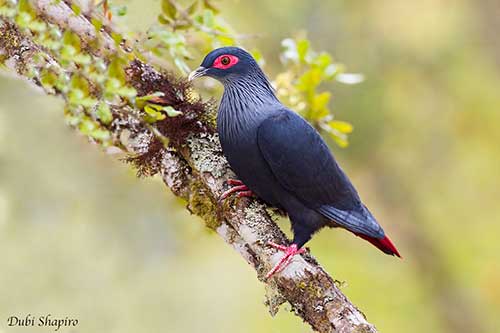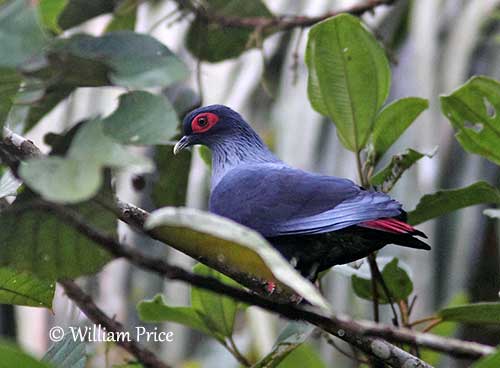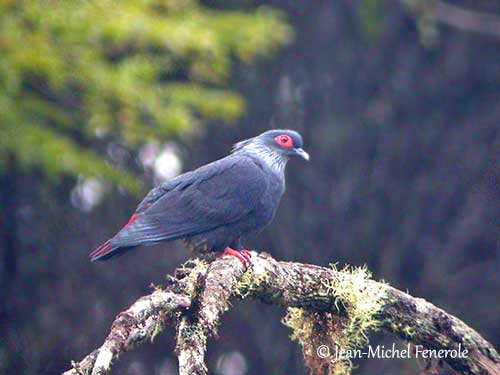
Fr: Founingo bleu
Ang: Madagascan Blue Pigeon
All: Madagaskarfruchttaube
Esp: Paloma Azul Malgache
Ita: Piccione blu del Madagascar
Nd: Malagassische Blauwe Duif
Sd: madagaskarblåduva
Mal: Finengo, Finengo mainty, Finengo manga, Finengo menamaso, Finengo menavody, vintsiala
Photographers:
Jean Michel Fenerole
Photos d’Oiseaux du monde
William Price
PBase-tereksandpiper & Flickr William Price
Dubi Shapiro
Dubi Shapiro Photo Galleries & Dubi Shapiro's Pictures on IBC
Text by Nicole Bouglouan
Sources:
HANDBOOK OF THE BIRDS OF THE WORLD vol 4 by Josep del Hoyo-Andrew Elliott-Jordi Sargatal - Lynx Edicions - ISBN: 8487334229
PIGEONS AND DOVES by David Gibbs, Eustace Barnes and John Cox - Pica Press Sussex - ISBN: 1873403607
The Birds of Africa: Volume VIII: The Malagasy Region: Madagascar, Seychelles, Comoros, Mascarenes - Par Roger Safford, Frank Hawkins – ISBN: 1408190494, 9781408190494- Editeur: A&C Black, 2013
Wildlife of Madagascar par Ken Behrens,Keith Barnes - ISBN: 140088067X, 9781400880676 – Editeur: Princeton University Press, 2016
Wikipedia, the free encyclopaedia
Madagascan Blue Pigeon
Alectroenas madagascariensis
Columbiformes Order – Columbidae Family
INTRODUCTION:
The Madagascan Blue Pigeon is endemic to Madagascar where it is found in the primary humid rainforest from sea-level to 2,000 metres of elevation in N and E of the island. It is often seen perched on tree-tops or flying above the canopy. It feeds primarily on fruits taken from trees or shrubs, but seeds and bugs are also part of its diet. Like most Columbidae, it nests in tree in a flimsy platform of twigs built by both mates.
The Madagascan Blue Pigeon is fairly common in several protected areas, but the population is declining due to hunting pressure and exploitation of forests.
DESCRIPTION OF THE BIRD:
Biometrics:
Length: 25-28 cm
The Madagascan Blue Pigeon has dark blue upperparts with silvery grey upper mantle. The upperwing is dark blue with violet-blue gloss. Rest of upperparts is black with violet-blue gloss and bluish-grey tips to feathers. Uppertail-coverts and tail feathers are red, the latter with black base.
On the underparts, chin, throat, neck and upper breast are silvery grey with fine dark streaks. Lower breast, belly, flanks and thighs are black with violet-blue tinge. The long undertail-coverts are dark red with paler bases. Underwing-coverts and axillaries are sooty black with violet wash on lesser coverts.

On the head, forehead, crown and nape are blackish with violet-blue tinge. The long, pointed feathers of neck and throat are silvery grey. Lores, cheeks and ear-coverts are blackish. We can see a conspicuous red bare patch around the eye that appears carunculated at close range.
The bill is greenish with yellow tip. The eyes are green-yellow surrounded by red ring. Legs and feet are red, with partially feathered tarsus.
Male and female are similar.
The juvenile is browner than adults with greenish-blue gloss. Head and neck are paler and the upperbreast is more plumbeous-grey and lacks the elongated feathers. The underparts are sooty brown with narrow buff fringes to feathers. The undertail-coverts have broad, buff and cinnamon fringes, and the red colour is more restricted on tail feathers. The bare red mask is smaller and the bare parts are duller than on adults.
RANGE:
The Madagascan Blue Pigeon occurs in NW and E Madagascar. The species is also recorded on Central plateau and at some scattered locations in W of the island.
HABITAT:
The Madagascan Blue Pigeon is found in primary humid rainforests, but also in heavily disturbed and intact forest. It can be seen near orchards and plantations, but it is less common in secondary growths adjacent to primary forests. The species is visible from sea-level up to 2,000 metres of elevation.
CALLS AND SONGS: SOUNDS BY XENO-CANTO
The Madagascan Blue Pigeon is more silent than other pigeons and it is rarely heard. Its voice is rather a muffled humming than a typical cooing. When attending the nest, the adults give a low, soft cooing call.
BEHAVIOUR IN THE WILD:
The Madagascan Blue Pigeon feeds largely on fruits plucked from bushes, shrubs and fruiting trees. It also consumes buds and seeds, but these seeds could be those of the eaten fruits. Fruits are swallowed whole, and several varieties are taken. The Madagascan Blue Pigeon is an important seed disperser.
It is often seen in pairs, but small flocks of 10-13 individuals are observed too.

The courtship behaviour is unknown, but we can suggest that they are similar to those of numerous Columbidae, with aerial displays and bowing display by the male accompanied by soft cooping. But this species is less vocal than congeners.
The Madagascan Blue Pigeon performs seasonal movements into the W of the island in November/December. It also descends to the plains between March and July, suggesting altitudinal movements. But further studies are required to understand these movements.
The flight is strong and fast and can be sustained over long distances.
REPRODUCTION OF THIS SPECIES:
The breeding season occurs from July to March, with most of laying in October/November.
The flimsy nest is built by both adults on horizontal fork, between 6 and 20 metres above the ground in tree or shrub. This shallow platform is made with loosely interlaced twigs.
The female lays a single white egg. Incubation and fledgling periods are unknown. Usually, the incubation lasts between 17 and 30 days in large species, and the young fledge in 28-30 days.
PROTECTION / THREATS / STATUS:
The Madagascan Blue Pigeon has locally declined due to hunting pressure. It is probably threatened by exploitation of forests, although it tolerates partially exploited primary forest. It is fairly common in several protected areas such as national parks and reserves.
In spite of decline of the population, the Madagascan Blue Pigeon is not globally threatened and currently evaluated as Least Concern.
